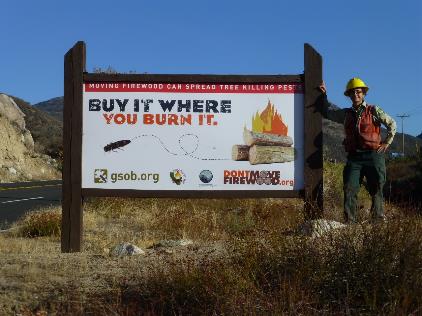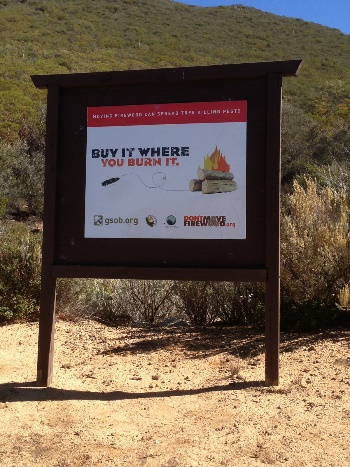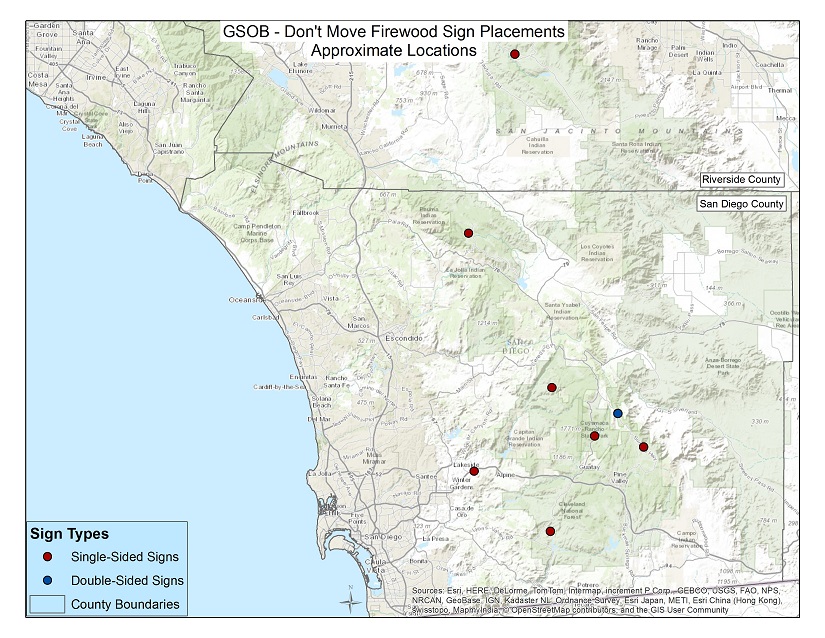Guest blog by Kevin Turner, Goldspotted Oak Borer Program Coordinator, University of California Riverside
In the spring of 2014, the California Firewood Task Force was able to offer “year-end funds” to the Goldspotted Oak Borer (GSOB) Outreach Committee for a much awaited roadside sign project in Southern California. Our multi-agency committee had conceived of the idea of using roadside signs to warn the populace about the danger of moving GSOB-infested firewood, particularly in light of the fact that there was no prospect of an oak firewood quarantine being established. A big surge in GSOB-caused mortality in San Diego County combined with the first discovery of GSOB in Riverside County increased the urgency of getting signs installed.

Sign at Highway 74 in route to Idyllwild – San Bernardino National Forest, California
With funding in hand, we set about coming up with a plan for determining sign design, placement locations, permitting requirements, procurement process, and sign installation. The Don’t Move Firewood campaign is well branded in California and nationally, so the committee felt that continuing the branding made sense. The Nature Conservancy’s Don’t Move Firewood campaign shared samples of sign designs being used in other states and offered the services of their graphic designer to help us with our customized design- at no charge! As you can see, our design highlights GSOB and features a white background to minimize fading in the strong California sun.
For sign locations, Cuyamaca State Park offered to place one sign on Highway 79 in the heart of GSOB country, and another at Mount Palomar, an area immediately at risk to GSOB. The Descanso Ranger District of the Cleveland National Forest identified three high-use recreation facilities where the signs would be effective. The City of San Diego Parks Department placed a sign at their Mission Trails facility which in July identified its first GSOB tree. CAL FIRE in San Diego is installing a 4’x8’ sign on one of their existing fire prevention sign locations. Finally, the Riverside County Mountain Area Safety Task Force utilized and existing San Bernardino National Forest sign location on Highway 74 between the city of Hemet and Idyllwild. Each agency that received a sign was responsible for pursuing whatever permitting or permission process was required.

Sign at Sunrise Highway in the Cleveland National Forest, California
A number of CAL FIRE Conservation camps produce “camp products” which include producing signs. We selected Norco Camp in Riverside County for this project because it was local and had the ability to utilize computer graphics for producing signs in custom sizes. Norco also built nice redwood sign frames for some sign locations without existing frames. When the signs were completed, CAL FIRE Riverside Unit/Riverside County Fire Department offered the use of their hook-lift truck and a driver to deliver the signs to various locations.
Things to consider if you are planning a future roadside sign project:
- Using a custom design produced by the Don't Move Firewood campaign allows your project to immediately be part of a well recognized national campaign- and the designs are done at no cost to your project.
- Signs placed at turnouts, vista points, entry kiosks etc. can contain more detailed information than signs on high-speed sections of roadway where vehicle occupants have a few seconds to view.
- Try to place signs on sections of roadway where drivers are not having to cope with merging, passing, high-speed cornering or other functions of driving that require their full attention.
- Signs at locations where people pull over, stop, or have to drive at a slower rate of speed offer the best opportunity for observation.
- Signs made of decals placed onto aluminum metal backings allow for changing the message or graphics periodically. However, signs produced with other materials and technologies may have an appeal.
- Check with the local regulatory agency to insure you are complying with signage laws.
- Sign designs can utilize frames on which signs are mounted or frameless (signs attach directly to posts with no frame.
- Consider rotating the signs with other messages; people become oblivious if they travel the same section of road, but a change catches their eye.
- Produce the largest size possible on existing sign boards.
- If using an existing sign frame, make sure to check out its condition and take appropriate replacement parts for worn components.
Many thanks to the agencies, groups and individuals that contributed to making this a successful team effort!

For questions regarding this project, please contact Kevin Turner, Goldspotted Oak Borer Program Coordinator, University of California Riverside



